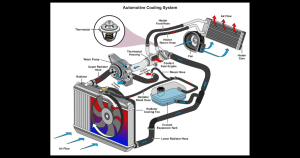 Your Honda’s radiator serves the vital function of keeping your engine from overheating and seizing up. When a car’s radiator breaks down, the engine is soon to follow. Always look out for the following four indicators of radiator trouble. If you notice any one of them, consider visiting your nearest Honda dealer at once for prompt radiator repair.
Your Honda’s radiator serves the vital function of keeping your engine from overheating and seizing up. When a car’s radiator breaks down, the engine is soon to follow. Always look out for the following four indicators of radiator trouble. If you notice any one of them, consider visiting your nearest Honda dealer at once for prompt radiator repair.
Your Engine Starts to Overheat
The cooling system in a car pumps coolant around the engine while it’s running, keeping the temperature down. As coolant fluid passes through the radiator, the radiator cools the fluid down. So a faulty radiator prevents the coolant from serving its purpose and causes the engine to overheat.
You’ll probably hear ticking or knocking sounds as the rods and pistons inside an overheating engine start to struggle. You’ll also smell something burning, your hood will become hot to the touch, and you might see steam or smoke rising from the front of your car. Hondas also have sensitive engine temperature gauges. As soon as your engine becomes too hot, you’ll see this temperature gauge shoot up.
Your Coolant Begins to Leak
There should always be an appropriate amount of coolant when any car is on the road. If your cooling system springs a leak, coolant levels will plummet and your engine will start to heat up. On the rare occasion when a leak occurs, coolant most commonly leaks from the radiator, one of the hoses connecting to the radiator, or a connection point where a hose joins the radiator.
To help make it visible, coolant is almost always a colorful liquid. It might be green, yellow, red, pink, or blue, and it often smells sweet. So if you pull away from parking and spot a puddle of brightly colored, sweet-smelling fluid on the ground, you probably have a coolant leak. You can check the coolant container under your hood to see if your coolant is within the recommended levels.
Your Radiator Has Significant Rust
When poorly maintained, radiators can rust from the outside or the inside. A car left disused for long periods of time will often gather moisture throughout the engine, which causes rust to form. This problem is more prevalent in very cold or humid climates. When rust is allowed to form extensively, it will eventually eat through the metal, causing structural damage to your radiator.
Over time, sludge can build up inside a radiator. This sludge also causes rust, which will eventually eat through the metal, causing leaks. You can prevent a buildup of sludge by periodically having your radiator drained and flushed out. Additionally, many types of coolant contain chemicals that counter the build-up of sludge and help to prevent rust and corrosion.
Your Honda Dealer Finds a Flaw
A well-kept radiator can easily last for nine or ten years. To help it last, it’s important to have your entire cooling system inspected at least once a year. This way, a technician can find any problems early on and either repair or replace the malfunctioning part before it leads to engine trouble.
Have your radiator inspected today at Performance Columbus. We’re a local family of dealerships with a broad selection of top-notch deals and vehicles, and our experienced technicians are standing by to take care of your investment!




